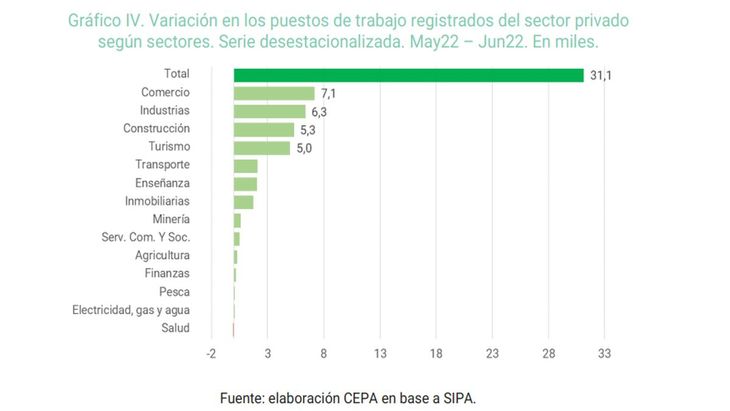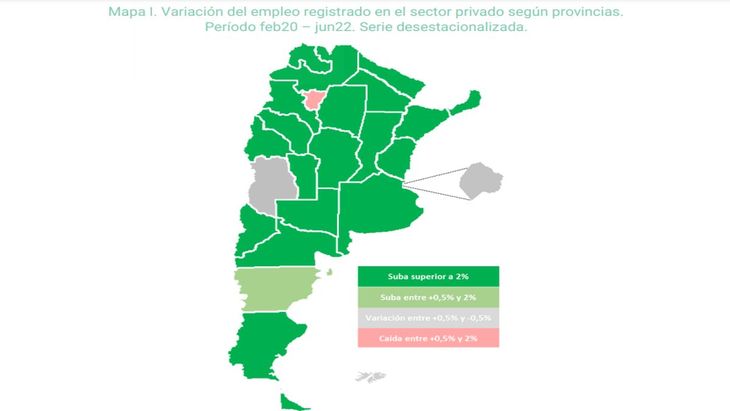And proof of this is the 6.4% year-on-year growth in economic activity in the month of June, which also represented an increase of 1.1% compared to May, as reported by INDEC last week. In this way, an advance of 6.3% was accumulated in the first semester with respect to the same period of the previous year.
Despite the fact that various analysts maintain that the trend will find a brake and deceleration as of July, the level of increase in activity allows the volume of employment in the private sector to continue recovering.
A study by the Center for Argentine Political Economy (CEPA) Based on official figures from Argentine Integrated Pension System (SIPA) points out that during the sixth month of the year practically all sectors of the economy showed a rise in the number of jobs.
The recovery was driven by Commerce, with 7,100 new jobs, Industries with 6,300, Construction with 5,300 and Tourism with 5,000. “The sectors of Health, Electricity, gas and water and Fishing, although they did not have significant growth in jobs, did not register their destruction either,” they reported from CEPA.
CEPA graphic work2.jpg
In this way, the total volume of private employment grew by 31,161 new jobs, with which it was possible to recover the level registered in February 2020 while 364 thousand jobs were recovered from the minimum floor produced by the pandemic in July 2020 .
“With the increase in employment in June, nine of the fourteen sectors already operate at levels of employment higher than the pre-pandemic, another three continue to grow and are close to said threshold and of the remaining three, which continued to destroy jobs after As of July 2020, only one does not currently create jobs,” the study points out.
However, it has not yet been possible to restore the jobs lost during the Cambiemos government, since, according to the report, 104,000 new jobs remain to be created in the private sector.
CEPA graphic work1.jpg

sectors
Despite this, the recovery is notorious and even in some sectors It happened quickly, as in the Building, that from public works managed to register employment growth of 9.7% compared to February 2020, being the most dynamic item.
Sectors such as real estate (7.5%) and Industry (6.4%), where 61,000 and 69,000 respectively have been created since then.
“Among the recovering sectors, Tourism It has been growing for 12 consecutive months. The significant increase experienced by this sector in recent months was mainly related to the tourist season and the positive impact of the Pre-Trip program”, they pointed out from CEPA. Although in June it continued to grow at 2%, “it is still significantly below pre-pandemic levels (-3.7%)”.
Finally, three sectors continue to be in crisis, despite the growth registered in June. It is the case of Transport, Agriculture Y Finance. In the case of the first, in the sixth month it grew 0.4%, but is still -2.3% below February 2020. In the second and third, the record was similar with a rise of 0.1% in June, but -2.2% and -3.5% below the pre-pandemic level, respectively.
CEPA graphic work.jpg

Regions
Finally, the study evaluated the evolution of the employment index in the Argentine provinces and the City of Buenos Aires. It follows that 21 of the 24 jurisdictions show volumes greater than February 2020.
To make it clearer, the STRAIN divided the country into four groups according to the level of growth or decline in employment and marked them with different shades of colors: dark green, light green, gray and red.
CEPA map.jpg

There it is observed that within the dark green group there are provinces that show variations above 2%. This is a good part of the country since it is made up of Tierra del Fuego, Catamarca, Formosa, San Luis, La Rioja, Misiones, La Pampa, Santiago del Estero, San Juan, Santa Cruz, Jujuy, Santa Fe, Entre Ríos, Río Negro, Chaco, Buenos Aires, Córdoba, Salta and Corrientes.
The second group (light green) shows those provinces that registered an increase of between 0.5% and 2%. This is made up of: Chubut. In third place, in grey, are the provinces at pre-covid levels: CABA and Mendoza. Finally, in red, Tucumán appears with between -0.5% and -2% compared to February 2020.
“The NEA and the Center remain the regions that show the greatest dynamism. For their part: the regions of Cuyo and NOA, the most affected by the pandemic, already register levels close to those of pre-pandemic “expressed from the CEPA.
The trend observed in the private labor market shows that more than a year after the pandemic floor, 364,000 jobs were created. This is more than 100% of the total lost since that date, although 104,000 still remain to be recovered to rebuild the labor network lost during the Cambiemos government.
Source: Ambito
David William is a talented author who has made a name for himself in the world of writing. He is a professional author who writes on a wide range of topics, from general interest to opinion news. David is currently working as a writer at 24 hours worlds where he brings his unique perspective and in-depth research to his articles, making them both informative and engaging.




